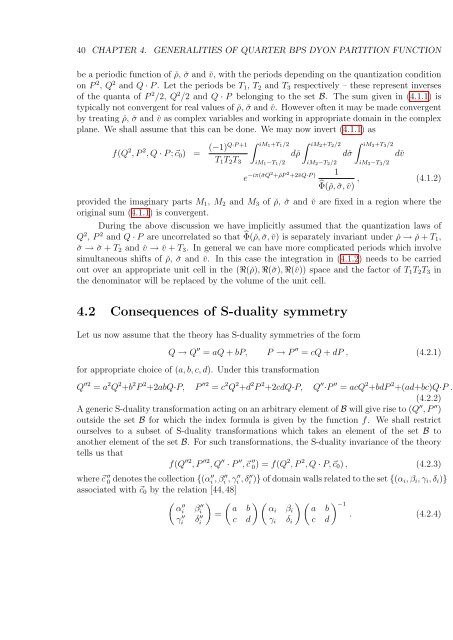PHYS08200604018 Shamik Banerjee - Homi Bhabha National ...
PHYS08200604018 Shamik Banerjee - Homi Bhabha National ...
PHYS08200604018 Shamik Banerjee - Homi Bhabha National ...
You also want an ePaper? Increase the reach of your titles
YUMPU automatically turns print PDFs into web optimized ePapers that Google loves.
40 CHAPTER 4. GENERALITIES OF QUARTER BPS DYON PARTITION FUNCTION<br />
be a periodic function of ˇρ, ˇσ and ˇv, with the periods depending on the quantization condition<br />
on P 2 , Q 2 and Q · P . Let the periods be T 1 , T 2 and T 3 respectively – these represent inverses<br />
of the quanta of P 2 /2, Q 2 /2 and Q · P belonging to the set B. The sum given in (4.1.1) is<br />
typically not convergent for real values of ˇρ, ˇσ and ˇv. However often it may be made convergent<br />
by treating ˇρ, ˇσ and ˇv as complex variables and working in appropriate domain in the complex<br />
plane. We shall assume that this can be done. We may now invert (4.1.1) as<br />
f(Q 2 , P 2 , Q · P ;⃗c 0 ) =<br />
+1<br />
∫ iM1 +T<br />
(−1)Q·P 1 /2<br />
dˇρ<br />
T 1 T 2 T 3<br />
iM 1 −T 1 /2<br />
∫ iM2 +T 2 /2<br />
iM 2 −T 2 /2<br />
dˇσ<br />
∫ iM3 +T 3 /2<br />
iM 3 −T 3 /2<br />
e −iπ(ˇσQ2 +ˇρP 2 +2ˇvQ·P ) 1<br />
̂Φ(ˇρ, ˇσ, ˇv) , (4.1.2)<br />
dˇv<br />
provided the imaginary parts M 1 , M 2 and M 3 of ˇρ, ˇσ and ˇv are fixed in a region where the<br />
original sum (4.1.1) is convergent.<br />
During the above discussion we have implicitly assumed that the quantization laws of<br />
Q 2 , P 2 and Q · P are uncorrelated so that ̂Φ(ˇρ, ˇσ, ˇv) is separately invariant under ˇρ → ˇρ + T 1 ,<br />
ˇσ → ˇσ + T 2 and ˇv → ˇv + T 3 . In general we can have more complicated periods which involve<br />
simultaneous shifts of ˇρ, ˇσ and ˇv. In this case the integration in (4.1.2) needs to be carried<br />
out over an appropriate unit cell in the (R(ˇρ), R(ˇσ), R(ˇv)) space and the factor of T 1 T 2 T 3 in<br />
the denominator will be replaced by the volume of the unit cell.<br />
4.2 Consequences of S-duality symmetry<br />
Let us now assume that the theory has S-duality symmetries of the form<br />
Q → Q ′′ = aQ + bP, P → P ′′ = cQ + dP , (4.2.1)<br />
for appropriate choice of (a, b, c, d). Under this transformation<br />
Q ′′2 = a 2 Q 2 +b 2 P 2 +2abQ·P, P ′′2 = c 2 Q 2 +d 2 P 2 +2cdQ·P, Q ′′·P ′′ = acQ 2 +bdP 2 +(ad+bc)Q·P .<br />
(4.2.2)<br />
A generic S-duality transformation acting on an arbitrary element of B will give rise to (Q ′′ , P ′′ )<br />
outside the set B for which the index formula is given by the function f. We shall restrict<br />
ourselves to a subset of S-duality transformations which takes an element of the set B to<br />
another element of the set B. For such transformations, the S-duality invariance of the theory<br />
tells us that<br />
f(Q ′′2 , P ′′2 , Q ′′ · P ′′ ,⃗c ′′<br />
0) = f(Q 2 , P 2 , Q · P,⃗c 0 ) , (4.2.3)<br />
where ⃗c ′′<br />
0 denotes the collection {(α i ′′ , β i ′′ , γ i ′′ , δ i ′′ )} of domain walls related to the set {(α i , β i , γ i , δ i )}<br />
associated with ⃗c 0 by the relation [44, 48]<br />
( ) ( ) (<br />
α<br />
′′<br />
i β i<br />
′′ a b αi β<br />
γ i ′′ δ i<br />
′′ =<br />
i<br />
c d<br />
) (<br />
a b<br />
γ i δ i c d<br />
) −1<br />
. (4.2.4)

















